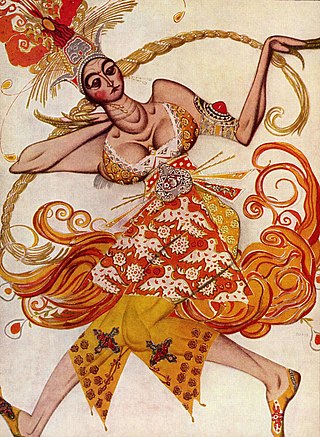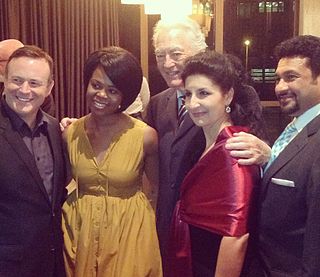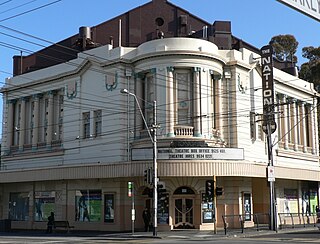Related Research Articles

The Rite of Spring is a ballet and orchestral concert work by the Russian composer Igor Stravinsky. It was written for the 1913 Paris season of Sergei Diaghilev's Ballets Russes company; the original choreography was by Vaslav Nijinsky with stage designs and costumes by Nicholas Roerich. When first performed at the Théâtre des Champs-Élysées on 29 May 1913, the avant-garde nature of the music and choreography caused a sensation. Many have called the first-night reaction a "riot" or "near-riot", though this wording did not come about until reviews of later performances in 1924, over a decade later. Although designed as a work for the stage, with specific passages accompanying characters and action, the music achieved equal if not greater recognition as a concert piece and is widely considered to be one of the most influential musical works of the 20th century.

Sir Robert Murray Helpmann CBE was an Australian ballet dancer, actor, director, and choreographer. After early work in Australia he moved to Britain in 1932, where he joined the Vic-Wells Ballet under its creator, Ninette de Valois. He became one of the company's leading men, partnering Alicia Markova and later Margot Fonteyn. When Frederick Ashton, the company's chief choreographer, was called up for military service in the Second World War, Helpmann took over from him while continuing as a principal dancer.
The Cecchetti method is variously defined as a style of ballet and as a ballet training method devised by the Italian ballet master Enrico Cecchetti (1850–1928). The training method seeks to develop essential skills in dancers as well as strength and elasticity. Cecchetti-trained dancers are commonly found in ballet and other dance companies throughout the world.

Dame Margaret Evelyn de Arias DBE, known by the stage name Margot Fonteyn, was an English ballerina. She spent her entire career as a dancer with the Royal Ballet, eventually being appointed prima ballerina assoluta of the company by Queen Elizabeth II.

The Firebird is a ballet and orchestral concert work by the Russian composer Igor Stravinsky. It was written for the 1910 Paris season of Sergei Diaghilev's Ballets Russes company; the original choreography was by Michel Fokine, who collaborated with Alexandre Benois and others on a scenario based on the Russian fairy tales of the Firebird and the blessing and curse it possesses for its owner. It was first performed at the Opéra de Paris on 25 June 1910 and was an immediate success, catapulting Stravinsky to international fame and leading to future Diaghilev–Stravinsky collaborations including Petrushka (1911) and The Rite of Spring (1913).

Richard Alan Bonynge is an Australian conductor and pianist. He is the widower of Australian dramatic coloratura soprano Dame Joan Sutherland. Bonynge conducted virtually all of Sutherland's operatic performances from 1962 until her retirement in 1990.
The Australian Ballet (TAB) is the largest classical ballet company in Australia. It was founded by J. C. Williamson Theatres Ltd and the Australian Elizabethan Theatre Trust in 1962, with the English-born dancer, teacher, repetiteur and director Dame Peggy van Praagh as founding artistic director. Today, it is recognised as one of the world's major international ballet companies and performs upwards of 150 performances a year.
English National Ballet is a classical ballet company founded by Dame Alicia Markova and Sir Anton Dolin as London Festival Ballet and based in London, England. Along with The Royal Ballet, Birmingham Royal Ballet, Northern Ballet and Scottish Ballet, it is one of the five major ballet companies in Great Britain. English National Ballet is one of the foremost touring companies in Europe, performing in theatres throughout the UK as well as conducting international tours and performing at special events. The Company employs approximately 67 dancers and a symphony orchestra,. In 1984 Peter Schaufuss became director and changed the name to English National Ballet and founded the school English National Ballet School, which is independent from the ballet company but joining the company premises in the new building. The Company regularly performs seasons at the London Coliseum and has been noted for specially staged performances at the Royal Albert Hall. In 2014 English National Ballet became an Associate Company of Sadler's Wells.

Queensland Ballet, founded in 1960 by Charles Lisner, is the premier ballet company of Queensland, Australia, and is based in Brisbane. It is one of only three full-time, professional classical ballet companies in Australia. The company has had six previous Artistic Directors, and is currently led by Greg Horsman.
Ceremonial dancing has a very important place in the Indigenous cultures of Australia. They vary from place to place, but most ceremonies combine dance, song, rituals and often elaborate body decorations and costumes. The different body paintings indicate the type of ceremony being performed. They play an important role in marriage ceremonies, in the education of Indigenous children, as well as storytelling and oral history. The term corroboree is commonly used to refer to Australian Aboriginal dances, although this term has its origins among the people of the Sydney region. In some places, Aboriginal people perform corroborees for tourists. In the latter part of the 20th century the influence of Indigenous Australian dance traditions has been seen with the development of concert dance, with the Aboriginal Centre for the Performing Arts (ACPA) providing training in contemporary dance.

Le Spectre de la rose is a short ballet about a young girl who dreams of dancing with the spirit of a souvenir rose from her first ball. The ballet was written by Jean-Louis Vaudoyer who based the story on a verse by Théophile Gautier and used the music of Carl Maria von Weber's piano piece Aufforderung zum Tanz as orchestrated by Hector Berlioz.
The Australian Elizabethan Theatre Trust (AETT) is an Australian theatre and performing arts company based in Sydney established in 1954. It is today especially known for its music scholarship program.
Dame Catherine Margaret Mary Scott, was a South African-born pioneering ballet dancer who found fame as a teacher, choreographer, and school administrator in Australia. As the first director of the Australian Ballet School, she is recognised as one of the founders of the strong ballet tradition of her adopted country.

Dame Margaret van Praagh was a British ballet dancer, choreographer, teacher, repetiteur, producer, advocate and director, who spent much of her later career in Australia.

The National Theatre is a 783-seat Australian theatre and theatrical arts school located in the Melbourne bayside suburb of St Kilda, on the corner of Barkly and Carlisle Streets. The building was constructed in 1921 as The Victory Theatre, rebuilt as 2550 seat cinema in 1928, finally converted to a live venue in 1972/4 with 783 seats. The stalls seating was converted to studios and rehearsal rooms for the schools.
The Original Ballet Russe was a ballet company established in 1931 by René Blum and Colonel Wassily de Basil as a successor to the Ballets Russes, founded in 1909 by Sergei Diaghilev. The company assumed the new name Original Ballet Russe after a split between de Basil and Blum. De Basil led the renamed company, while Blum and others founded a new company under the name Ballet Russe de Monte-Carlo. It was a large scale professional ballet company which toured extensively in Europe, Australia and New Zealand, the United States, and Central and South America. It closed down operations in 1947.

Edouard Borovansky was a Czech-born Australian ballet dancer, choreographer and director. After touring with Anna Pavlova's company, he and his wife, Xenia, settled in Australia where they established the Borovansky Ballet company. This company provided the foundation for modern ballet in Australia and was subsequently used as the basis for the first national Australian ballet company, The Australian Ballet which was established in 1962.

The Sentimental Bloke is a 1961 Australian musical by Albert Arlen, Nancy Brown and Lloyd Thomson based on Songs of a Sentimental Bloke by C.J. Dennis. Set in Melbourne, it is one of the most successful Australian musicals of the 20th century.
Christopher Muir was an Australian director and producer, notable for his work in TV in the 1950s and 1960s. In the 1980s he was head of ABC Television drama.
The Forbidden Rite is a 1962 Australian television play. It is a filmed ballet - the first ballet written in Australia exclusively for TV. The ABC did regularly broadcast ballet at the time.
References
- ↑ ""ONE IN FIVE" PREMIERE". The Australian Women's Weekly . Australia. 19 December 1962. p. 3. Retrieved 25 January 2020– via Trove.